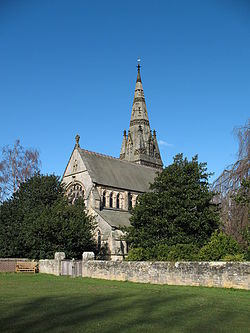
Here is a tale of a murder. A murder which led to the building of a very fine church not many miles from here.
In 1870, Frederick Vyner, son of the Marquess of Ripon and Lady Mary Vyner, travelled to Greece with a small band of English and Italian friends and servants. They were set upon by brigands who had probably been tipped off, and who demanded a huge ransom: £50,000. Women, children and servants in the party were regarded as useless bargaining tools by the brigands. They were released. But five men remained captive, including Frederick. The money was found to pay off the ransom, but before it could be delivered, the Greeks sent in the army, and in the resulting battle, soldiers, brigands and four of the hostages were killed, among them Frederick Vyner.
Vyner’s mother, Lady Mary, determined that she would build a church in her son’s memory on the Newby Hall estate which was their home. Her sister, Lady Ripon, was at the same time engaged in a project to build a church at Studley Royal, Fountains Abbey, Ripon. William Burges , noted Victorian architect, obtained the commissions for both churches in 1870.
I’m going to get to know St. Mary’s Church, and the work of William Burges very well over the weeks and months to come, as I have just been accepted as a volunteer for the National Trust at Fountains Abbey, where one of my duties will be as an Information Assistant at the church. Yesterday though, as part of our training, we were taken to see the church at Newby, which was until the 1990’s, the parish church of the village of Skelton-on-Ure.
It’s clearly Saint Mary’s sister church, yet more stolid, more weighty in appearance. Originally to have been called St. Michael and All Angels, the church has a unique dedication – to Christ the Consoler. Wander round the outside, and you’ll see over the door Christ the good shepherd with some of his ovine flock: a complement to the sheep in the field beyond, at the moment nursing their young lambs.
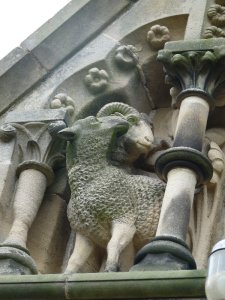
Within and outside the church Christ is omnipresent, perhaps most spectacularly in the rose window which portrays Him at its centre. The several ages of man are illustrated on an inner wheel of glass, and the various occupations and conditions of man on an outer wheel: noblemen at the top, working types below. Curiously, being ‘negro’, seems to be a job in itself. All turn their gaze upon the risen Christ the Consoler as they go about their business. It’s easy to imagine this spectacular window being a teaching aid to any cleric needing material for his sermon.
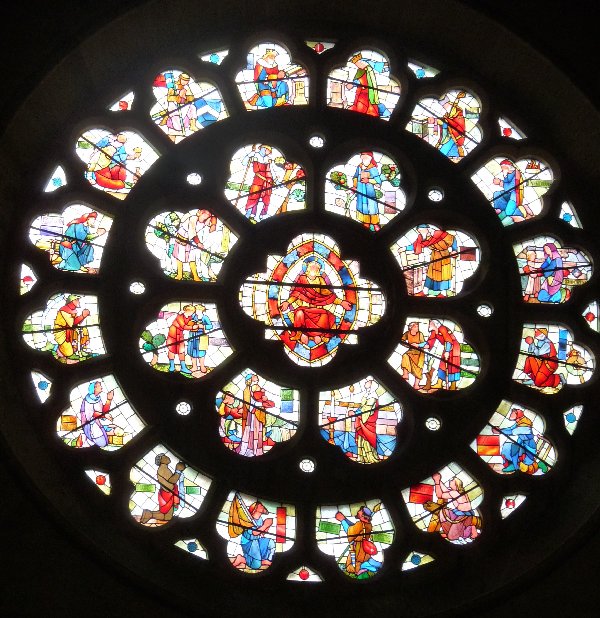
Walk down the nave and you’ll witness the miracles of Christ on one side, his parables on the other, each complemented by the event from the Old Testament which is traditionally held to be the precursor of that in the New Testament. This one was my particular favourite: the Annunciation, whose forerunner was the story of Moses and the burning bush.

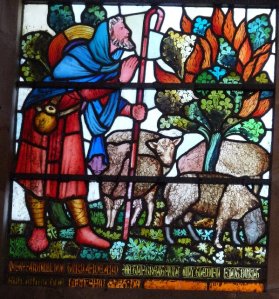
The dominating view as you enter the church is an almost overwhelming sculpture above the entrance to the chancel. Here is Christ’s Ascension with a crowd of 12 looking on. These are the disciples of course: but not Judas. His place is taken by Mary: a very mediaeval take on the event.
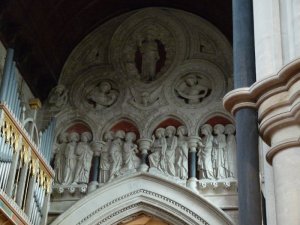
The chancel itself forms an intimate place for the Vyner family. Heraldic misericords record the arms of close and more distant branches of the family, all surrounding as if to embrace the memorial to the murdered young Frederick in a private and understated way. It’s decorated, as is St. Mary’s, with columns in Irish marble: dark green, plum red, greyish-white. More stained glass windows of Christ carrying his cross, then crucified, each with a number of Old Testament precursors.
There’s more. There’s a glittering reredos with the Magi. There’s a spectacular organ casing set before the chancel. There’s detail to keep you happily busy and exploring for hours. Newby Hall and its gardens ought to be on your tourist map if you explore our area. Don’t leave the church out of your itinerary.
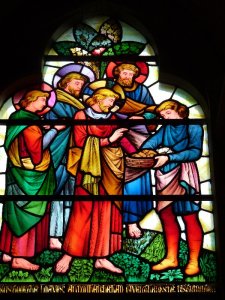
As for William Burges, and the story of the two churches he built here near Ripon… well, there’s plenty here for another day
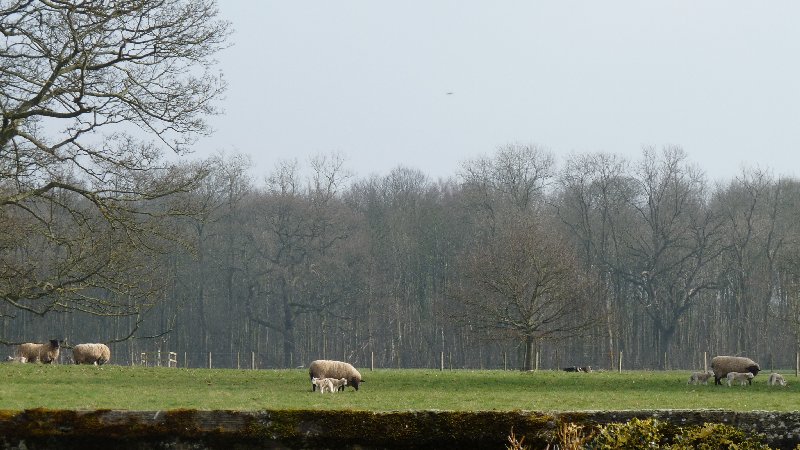








It really is a lovely church, isn’t it? I’m glad you will now be able to tell me far more about it! I love the fact that it’s a unity – all in one style.
LikeLiked by 1 person
Oh, I should have known you’d already know it well. It’s wonderful, as is St, Mary’s. I’m looking forward to getting to know them both better. Loved your eclipse photos by the way. We saw nothing here. Too cloudy.
LikeLike
You live in a beautiful area. I love the photo of the view towards the forest from the churchyard. It appeals to me that there is a church which, at least in that direction, has no other buildings in view all the way across fields to a distant forest.
LikeLike
It’s in the apparently almost endless parkland of the Newby Hall estate. Parishioners from the village would have had a picturesque walk through the woods. It’s not bad!
LikeLiked by 1 person
I would have said that the one window was of a slave who probably had a forced conversion …or as they would erroneously have called it back then – salvation.
LikeLike
Yes, perhaps. But although we were happy enough to profit from the shipping of slaves via Liverpool and Bristol, we had no slaves from Africa in the UK, and by the time the church was built, the slave trade was illegal.
LikeLiked by 1 person
That would be an interesting point to make when you do your docent tours – bet you’ll be a good one!
LikeLike
Well, come and check me out!
LikeLike
Fascinating story – and it looks like an itinerary for our trip is beginning to form!
LikeLike
So much to do, so little time……
LikeLike
We saw St Mary’s church today when we walked through Studley on our return from the Sunday ramble. John gave us a little talk about the Vyner family as we passed by. A lovely walk today, although some of us only did seven and a half miles instead of the advertised eleven with Christine.
LikeLike
Oh, I’d have loved to have been with you today: I’ve hardly come out with everyone at all this year. But so much to get done before Barcelona. We still have your Turkey book as well. When are you off?
LikeLike
What a very interesting church. It’s so informative to see a whole complete project encompassing architecture, sculpture and stained glass. For me, the Victorian’s Gothic Revival gives us some beautiful, passionate examples of sculpture, but their reinterpretation of medieval stained glass often comes across as a little flat and somewhat sentimental.
How lovely to be a volunteer at Fountains – glorious, stunning site. You really feel as though you are walking in the steps of the Cistercians. I hope you enjoy your volunteering experience – I do envy you!!
LikeLike
I’ve had a brilliant day: observing only so far. Dressing up with a gang of 6 year olds to introduce them to A Day in the Life of a Monk. Actually, I like the glass at Christ the Consoler, but in general I agree with you. I’m looking forward to getting more involved with the work of Burges, which has been a closed book to me till now.
LikeLiked by 1 person
We visited the Newby church last year – fascinating place. It’s ‘famous’ too for the ghost monk picture taken in the aisle some time ago and never successfully debunked.
http://www.theparanormalguide.com/blog/the-ghost-monk-of-newby-church
LikeLike
Ooh. That’s a new one on me. I don’t really ‘do’ paranormal though. Glad you’ve had a memorable weekend.
LikeLike
The negro is posed to suggest abject gratitude – Ripon.s ancestor, Viscount Goderich, aka ‘Prosperity’ Robinson, apart from being Prime Minister for 144 days (disastrously) in 1828 was a lifelong opponent of slavery (see his remarks as Colonial Secretary on Rev Bridges in Jamaica reported in the Anti-Slavery Reporter online) and carried it on after emancipation in the 1830s. Tory, of course – reform is handed down by enlightened and good men from above – campaigning and petitioning for it is very poor form.
LikeLike
Thanks so much for this enlightenment. I need to gen up!
LikeLike